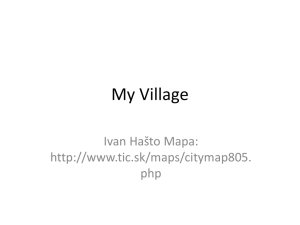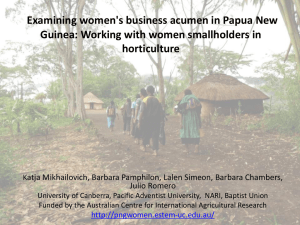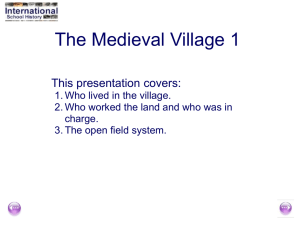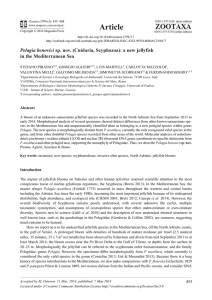Circular walk from Frati via Agia Pelagia
advertisement
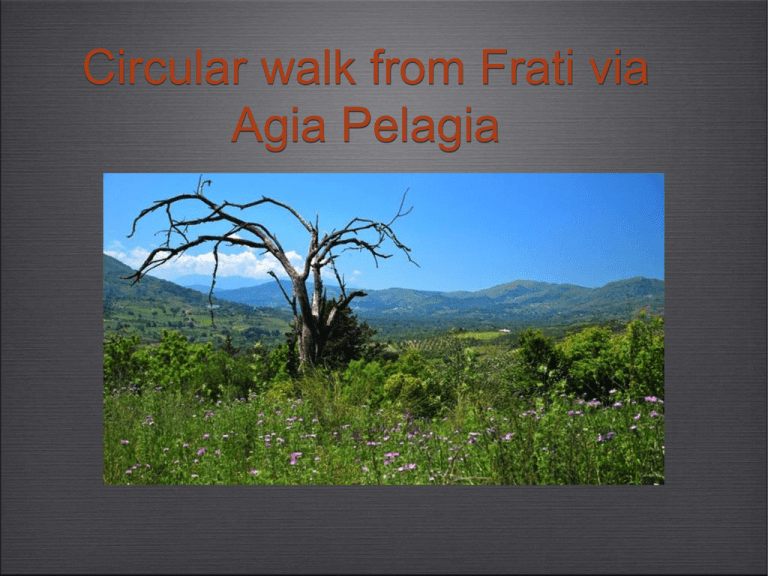
Circular walk from Frati via Agia Pelagia 10 6 7 8 11 9 12 5 13 14 4 3 15 2 1 Starting opposite the cemetry in Frati follow the blue dotted line for a leisurely 3-hour stroll taking in the traditional working village of Agia Pelagia and the abandoned village of Mixorrouma. Along with some wonderful views this walk gives a real insight into rural Crete. Walking is on tracks and paths with no stiff climbs, along the walk you will see plenty of other tracks you will want to explore in the future. 1 Park your car under the shade of a tree at the cemetery on the Frati to Agia Pelagia road, the start of the walk is the surfaced road almost opposite the cemetery, after 100metres the road forks, the right fork goes up to a small house, take the left fork 2 To your left there are great views of the awesome Kourtaliotiko gorge and the road leading to Plakias The route tracks high above the road to Spili and Rethymno on your left. In summer the hillside can look dry and barren, in springtime the roadside is awash with flowers 3 This particular shepherd dog may not be on guard when you walk but one of it’s offspring probably will be. These dogs are usually chained - but some aren’t so take care. Methods of dealing with these noisy - but mostly harmless - dogs varies. Doglovers fill their pockets with treats to ingratiate themselves with the unfortunate beasts, my preferred method is to wave a stick and look menacing, this usually confuses the animal long enough to sneak past A goatfold on your left displays the remains of some of its more extravagantly horned former inmates. I’m not sure of the purpose of this display but it’s a common site on Crete 4 After around 30 mins walking (depending on your guard-dog avoidance tactics) look out for this battered sign to the chapel of St Antony. Don’t do the obvious and assume the sign points in the direction of the chapel, it’s actually down a little-used track on the right of the road you are walking - you may have to hunt around for the track but the chapel, is only 5 minutes from the road and well worth the diversion This is the track leading to the chapel, it may not be immediately obvious but you will find it. See in the picture nets ready to be put in place for the olive harvest. Built into the rock-wall of the mountain, the chapel is in a beautiful secluded and shaded spot. It’s too early in the walk to make a start on your cheese pies but it is difficult to tear yourself away from this peaceful place so just take a seat and enjoy the solitude - or write a poem if you are a literary type The interior has some rather sombre wall paintings, relatively modern I suspect ‘though I am no expert on theological art. Personally I am always pleased to return to the sunlight and to the temptation of giving the bell rope a mighty swing 5 Sixty minutes into the walk and this old threshing circle marks the approach to the wonderful village of Agia Pelagia - one of my favourite places in Crete. On both sides of the track are signs of the industry of the villagers, olives, vines, fruit trees, stone-strewn fields sown with wheat and smaller plots for potatoes, aubergine and tomatoes, an amazing abundance of good natural food and in summer it’s tempting to fill your belly and rucksack with this tasty harvest 6 Approaching Agia Pelagia there are wonderful views on the left side of the track 7 Getting closer to the village look out for the two springs, a magical place where the villagers come to picnic in the spring and summer With makeshift seating and tables, the springs are a marvellous place to break your walk and enjoy lunch and a glass of wine - if you bought the local variety in plastic bottles the grapes were probably harvested in the hills around the village. 8 You are now walking on the E4 European Hiking Path, although shown on good maps, following it on the ground is more difficult. A few years ago these yellow and black E4 signs appeared marking the route across the island, most are now gone - destroyed by shotgun practice, eaten by goats or simply removed. Yes, it’s another E4 sign, keep walking the village is just around the corner. Off this track to the left are vineyards, the grapes produce a terrific red wine and the stalks and skins an equally memorable Raki 9 Look out for these trees on your left as you approach the village, here you can take the right fork which runs through the ‘back’ of the village or the left fork which is the village main street. Whichever route you take, you will end in the same place. Near here lives Uncle Marcos who, over a few Raki’s showed, me how to peel and prepare artichokes, nibbling the tiny white nutty part at the base of each leaf, before removing the fluffy interior, slicing and soaking in lemon juice - the entire operation performed with a knife which looked as if it might have seen service against the Turks and cleaned for the process by wiping on his trouser leg. Artichokes, like raki and just about everything else grown or reared in a Crete village is good for you. 10 This is entering the village from the lower, left fork. When I first came to Crete nearly 20 years ago it seemed like the battered pick-up was the standard form of transport in south coast villages, now like the donkey this form of transport is being replaced by massive 4-wheel drive ATV’s, I’m not sure if it’s the donkey or battered pick-up I miss the most. There are plenty of these old trucks still around, gently rusting away under the shade of olives trees and even some, like this one in Agia Pelagia, still transporting goats, sheep, animal feed, firewood, furniture and people. It’s a real pleasure just to stroll around the village, parts of which can hardly have changed in the last 50 years There are some great photo-opportunities in the village making Raki in Agia Pelagia If you have been on Crete for longer than 24 hours you will probably have been offered a Raki - the potent symbol of welcome and hospitality throughout the Island. An industrial distilling process satisfies the souvenir trade but the Raki you will be offered in restaurants and Tavernas is made by the owner, his father, uncle or cousin in a village like Agia Pelagia. The days of Raki making are a great social time in the village and if you are lucky enough to be invited to a Raki making session don’t miss it. Raki making is in early October, when wine making leaves a residue of mushed grape stalks, skin and seeds - you can see great plastic vats of the stuff by the roadside waiting to be processed. This unpleasant looking mush is used to create Crete’s wonder drink, the cure for all ailments (and probably the cause of quite a few). The distilling process is simple, the grape mush is boiled in ancient copper stills over roaring wood fires and the distilled liquour drips through an old cloth into 5 litre plastic jugs. It is a communal activity lasting several days during which time much food, wine and of course Raki is consumed. Photograph on the left was taken in Mixorouma, photo on the right shows Yiannis stoking a still in Agia Pelagia 11 Wether you take the upper or lower road through Agia Pelagia you will rejoin the main Frati to Mixorouma road on the outskirts of the village and in about five minutes reach the main Rethymno to Spili road, just before the main road there is a smaller road on the right, take this road through the back of Mixorouma village. After another 5 minutes you will reach a junction, take the right fork down to the abandoned village of Ano Mixorouma, another right fork skirts the old village which you can see on your left. It’s an interesting detour to stroll around the old village where there are some wonderful views from the church, below the church there’s an interesting property restoration, Angelika the owner has some pet ducks which you can see swimming in the river below the property. Abandoned houses in the old village of Mixorouma - if you are looking at these on your left you are on the right road 12 Further along this road on the right hand side are more abandoned buildings, this is an old mill 13 There are wonderful views on your left across the valley where you can see lots of tempting tracks to explore. A longer, more adventurous walk is through the old village of Mixorouma, here, keeping the valley and river to your right you climb to a higher track just visible in the photograph above, to return to Frati you will eventually have to cross the valley, although there is no obvious route, a track across a side valley coming in from the left will eventually allow you to cross the valley and the river and rejoin the Frati Mixorouma track. Save that walk for another time and today just enjoy the sound of the river in the valley below, eventually you will be on the valley floor with the river beside you. 14 From this point the route back to Frati is well signposted, just follow these brown and white signs There are many small chapels in the valley on your left, you can see two from the track, it’s easy to scramble down to explore these, there are terrific views down the to the gorge and the river which eventually reaches the sea at Prevelli Beach. Although it’s tempting, don’t try to climb down to the bottom of the gorge from here - there’s no obvious route and some alarming vertical drops. 15 Almost back to the start of your walk, the impressive peak on the left is Xiron (904m) you can see Frati village top right in the photograph, the final climb up into the village takes you past some particularly noisy dogs but don’t worry they are always tethered. At the main road turn right to return to your car or better still, left into the village of Frati for a Frappe or a beer in the small taverna. Depending on how long you lingered in Agia Pelagia and Old Mixorouma you will be back in Frati in around 3 hours, it’s a wonderful valley walk with lots of other tracks you will want to return to and explore during your holiday. In fond memory of Yiannis polychronakis The Spirit of Agia Pelagia

